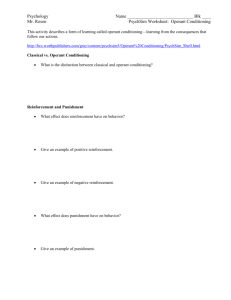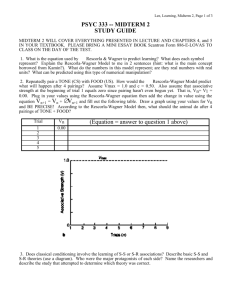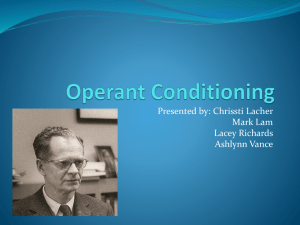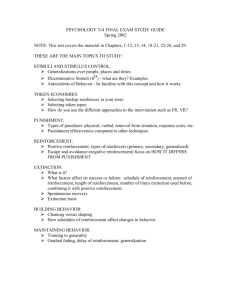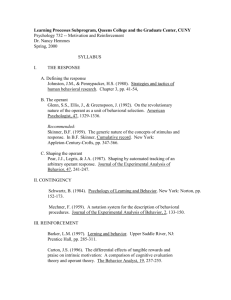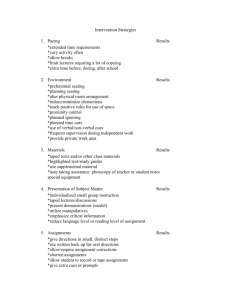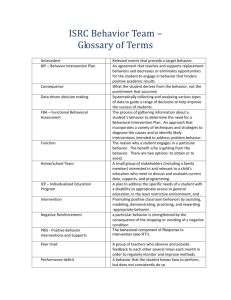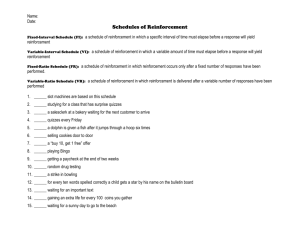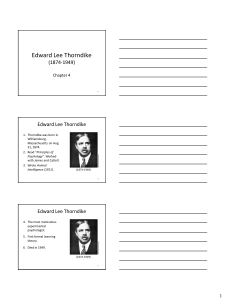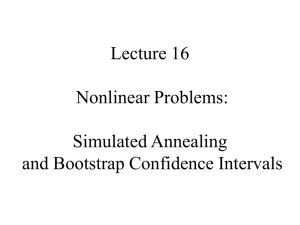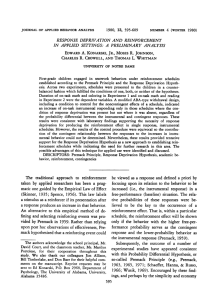Study Guide 2
advertisement
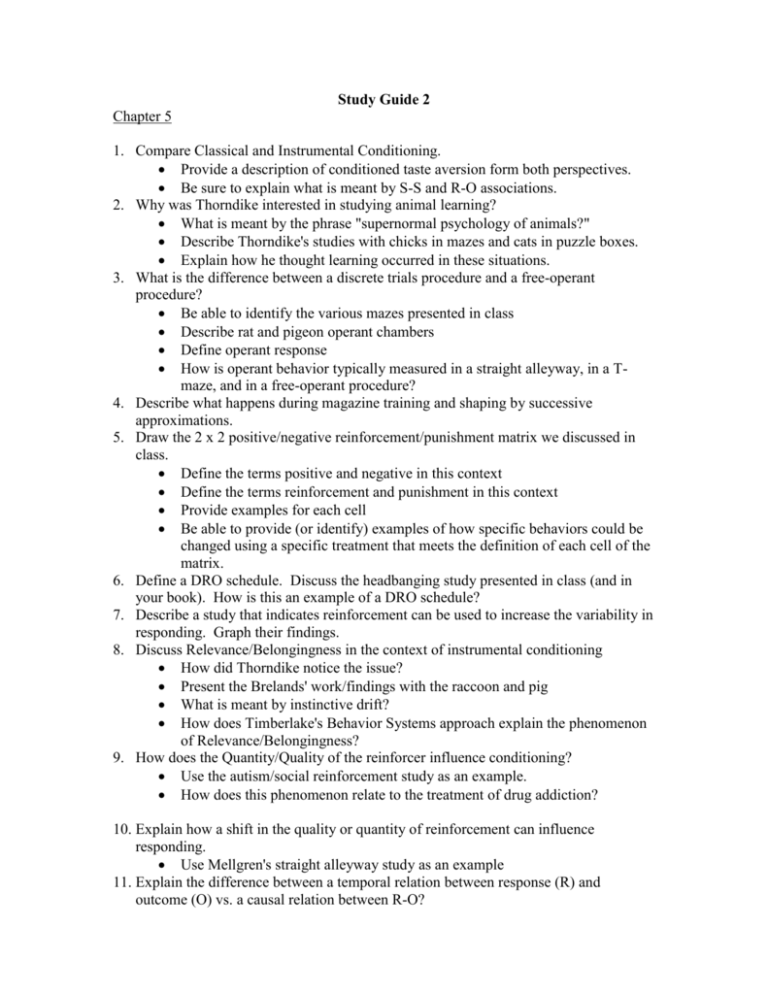
Study Guide 2 Chapter 5 1. Compare Classical and Instrumental Conditioning. Provide a description of conditioned taste aversion form both perspectives. Be sure to explain what is meant by S-S and R-O associations. 2. Why was Thorndike interested in studying animal learning? What is meant by the phrase "supernormal psychology of animals?" Describe Thorndike's studies with chicks in mazes and cats in puzzle boxes. Explain how he thought learning occurred in these situations. 3. What is the difference between a discrete trials procedure and a free-operant procedure? Be able to identify the various mazes presented in class Describe rat and pigeon operant chambers Define operant response How is operant behavior typically measured in a straight alleyway, in a Tmaze, and in a free-operant procedure? 4. Describe what happens during magazine training and shaping by successive approximations. 5. Draw the 2 x 2 positive/negative reinforcement/punishment matrix we discussed in class. Define the terms positive and negative in this context Define the terms reinforcement and punishment in this context Provide examples for each cell Be able to provide (or identify) examples of how specific behaviors could be changed using a specific treatment that meets the definition of each cell of the matrix. 6. Define a DRO schedule. Discuss the headbanging study presented in class (and in your book). How is this an example of a DRO schedule? 7. Describe a study that indicates reinforcement can be used to increase the variability in responding. Graph their findings. 8. Discuss Relevance/Belongingness in the context of instrumental conditioning How did Thorndike notice the issue? Present the Brelands' work/findings with the raccoon and pig What is meant by instinctive drift? How does Timberlake's Behavior Systems approach explain the phenomenon of Relevance/Belongingness? 9. How does the Quantity/Quality of the reinforcer influence conditioning? Use the autism/social reinforcement study as an example. How does this phenomenon relate to the treatment of drug addiction? 10. Explain how a shift in the quality or quantity of reinforcement can influence responding. Use Mellgren's straight alleyway study as an example 11. Explain the difference between a temporal relation between response (R) and outcome (O) vs. a causal relation between R-O? Why is it somewhat difficult to examine temporal relationships between R-O in a free-operant situation? How does the experienced delay in outcome/reinforcement influence operant responding? Why are animals so sensitive to the delay between R-O? What is a marking procedure? How does it affect learning with long delays between R and O? 12. Describe Skinner's Superstition experiment Did his finding support a contingency or contiguity view of learning? Describe how the superstition experiment has been reinterpreted from a behavioral system view. 13. Is having control over the outcomes in an operant situation a good or bad thing? What did Brady find in his executive Monkey study? What was wrong with this study? What has been shown in the learned helplessness work? Describe the triadic-design/findings. Describe the learned helplessness hypothesis. Chapter 6 1. Describe the various simple schedules of reinforcement. Also describe what responding is typically like on each of the schedules CRF FR VR FI VI 2. What is a limited hold schedule? 3. Compare responding on ratio and interval schedules. Which schedule causes more responding? Why? molecular view molar view 4. Describe Concurrent schedules of reinforcement. How is it done? How is responding measured? Relative rate of responding Know how to calculate Relative rate of reinforcement Know how to calculate 5. Define the matching law. Provide the equation. Describe Herrnstein’s study that demonstrated the matching law Draw a graph that shows what he found. 6. Describe the Law, Bullow, and Meller (1998) study that applied the matching law to sexual activity in adolescent girls What did they find? 7. Describe the concurrent chain schedule How was it used to compare VR and FR schedules? Which was preferred? 8. Describe how the concurrent chain schedule was used to study self control in pigeons (Rachlin and Green, 1972) What did they find? 9. Provide the equation for the value discounting function. Define each of the terms. 10. Describe how Madden, Petry, Badger, and Bickel (1997) used the value discounting function to compare self control in heroin users versus controls. What did they find? Chapter 7 1. What is the difference between the associative structure model and the behavioral regulation model of what motivates instrumental responding? 2. Define the Law of Effect 3. Describe Thorndike’s S-R view of instrumental conditioning. Make sure to include all of the components and how they are related. 4. In what domain of psychology is Thorndike’s view of S-R learning still influential? 5. Describe how Hull and Spence added expectancy to the S-R model. Two process theory 6. Describe the modern two-process theory (Rescorla and Soloman, 1967). Be sure to discuss how Pavlovian and instrumental conditioning interact Describe the Pavlovian-Insrumental Transfer Test How is this related to conditioned suppression procedures how do both procedures provide evidence for two-process theory? 7. Describe an outcome devaluation study (Colwill and Rescorla, 1986). How is this evidence for R-O relations? 8. Describe Sheffield’s consummatory response theory Be sure to explain how this fundamentally changed the view of the reinforce 9. In what way did David Premack disagree with Sheffield? 10. Describe the differential probability principle (Premack Principle). Describe the study with rats that we discussed in class that provides evidence for this principle. What was found? Describe the study with kids that we discussed in class that provides evidence for this principle What was found? 11. What does it mean that Premack’s definition of reinforcement is strictly empirical? 12. What is the behavioral bliss point? 13. Draw a graph that illustrates the behavioral bliss point for studying and watching TV Now draw the line that defines imposing a contingency that TV watching must match study time. 14. Define what is meant by the minimum deviation model (Staddon) Do your best to add the minimum deviation point to the graph you drew for question 13. 15. Explain how understanding of the behavioral bliss-point allows behavioral therapists to make some counterintuitive predictions when applying behavioral therapy (Figure 7.9).
